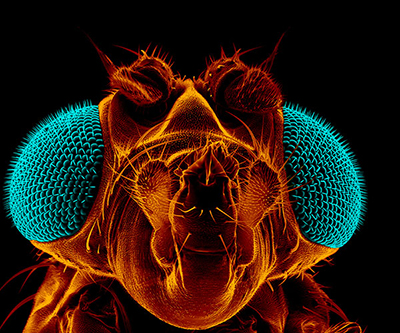
Scanning electron microscopy image of a fruit fly’s head.
Credit: Stock image
In eukaryotic organisms, a cell’s genetic material, or DNA, is packed inside the nucleus, which is surrounded by the nuclear envelope. Proteins and molecules can only enter or exit the nucleus through regulated channels through the nuclear envelope called nuclear pores that are built from roughly 30 different proteins. Advances in research techniques, such as CRISPR gene editing, have helped scientists better understand the unique roles of individual nuclear pore proteins.
The Dasso Lab studies the nuclear pore and its related complexes and proteins, including RanGAP. In simple eukaryotes, like yeast, RanGAP is dispersed throughout the cytoplasm. By contrast, complex organisms, like fruit flies, frogs, and people, have additions to RanGAP that target it to the cytoplasmic side of the nuclear pore, suggesting an evolutionary purpose for this localization. However, scientists were unsure why this is important.
In a recent study, researchers from the Dasso Lab reported that nuclear tethering of RanGAP appears dispensable for growth of human cells in culture, but it is required for the pupal stage of development in Drosophila, or fruit flies. The researchers engineered cells in which RanGAP that could not be recruited to the nuclear pore. They were surprised to find that cultured human cells could still grow and divide normally under these conditions. Fruit flies that did not recruit RanGAP to their nuclear pores developed normally through larval stages. However, when the flies reached the pupal stage, the researchers observed stark developmental defects that resulted in death.
The findings suggest that localization of RanGAP to the nuclear envelope is mostly dispensable for the growth and function of individual cells. However, this localization may be important for other processes, such as the formation of organs and other larger structures. Identifying these types of regulatory differences can help scientists better understand what is necessary for healthy development.
Learn more about the Cell Regulation and Development Affinity Group: https://www.nichd.nih.gov/about/org/dir/affinity-groups/CRD.
 BACK TO TOP
BACK TO TOP